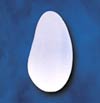Breast implants can get complications. We all know this, and try to do everything we can to minimize it.
I had a patient who presented to me with a seroma. She had implants placed years before by another surgeon who used Siltex implants. She was fine until one day BOOM her breast looked multiple sizes larger. It wasn’t a bleed. It was a seroma, which is a collection of this clear/yellow/pinkish fluid. I had never seen it before. So I found this article interesting.
You will find most busy breast augmentation surgeons use smooth round implants. People often ask me why I don’t use shaped “anatomical” implants. It does seem if you put in something which looks more like a breast shape it would be better, yes? The answer is the anatomical implants available to us in the United States (the style 410/gummy bears are not available here) when placed behind the muscle don’t give you much shape advantage, they can rotate, and a new study indicates they have a higher risk for double capsules and late seromas.
Plastic and Reconstructive Surgery Journal issue from January 2011 had an article on “Breast Implant Complication Review: Double Capsules and Late Seromas” by Elizabeth Hall-Findlay. For those of you with no attention span, the conclusion was the problem was not seen in smooth saline or gel breast implants. It was only seen in aggressively textured implants.
Textured implants were originally used because they thought texturing the surface would decrease capsular contracture rates. It is also necessary in a shaped implant, as the pocket of the implant is important- it needs to have the right size and orientation. The texturing helps “hold” the implant in position.
Dr. Findlay Hall researched these late seromas. A theory of these seromas is they are due to an unusual late infection or biofilm. But cultures are often negative. In her review, she only found the double capsule and spontaneous late seromas in one kind of implant: the biocell textured implant. There are different degrees of texturing: some have fine, small bumpiness in texture, others more aggressive. The bioocell are those with the most aggressive texturing, and in her review all of her seromas were in that type.
She theorizes “the initial adherence of the capsule to the textured implant becomes separated, with minor trauma resulting in two rough surfaces that create a seroma because of the shear forces involved.” She found “the capsule on the Biocell adheres like Velcro and can be separated with finger dissection,” and isn’t as adherent as the capsule on other textured type implants. The infection or biofilm explanation does not explain why she only found it in the textured implants. And it was seen in round/anatomic and pre/post muscle placement.
So blah blah blah. What does this mean?
Biocell and textured implants (except for the style 410, but those aren’t available in the US) have issues with double capsules and seromas. It is a low rate, but it gives me yet another reason to stick with the smooth round implant.
